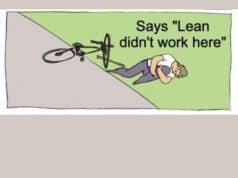I received an email from an MBA student in Turkey (this truly is a global lean community). The emailer asked me a question (which I posting here with permission):
I am doing research for my project at school. I noticed that on your website you mentioned that you are involved with medical environment. What kind of things can be poka yokes in a hospital clinic (for records not to encounter forms not to get lost, for patients not to wait too long, for doctors to come to clinic on time, to make sure that viist rooms are clean and front desk staff is notified without having to be told by another nurse etc.)?
I replied that there are many opportunities for poka yokes in healthcare, but ones I could come up with were:
- Surgeons required to write an “X” or “NO” on the left leg if surgery is to be performed on the right leg
- Nurses checking wristband ID's before giving drugs or taking blood
- Scanning bar code wristbands to make sure proper drugs are given to proper patient
The emailer wrote back that they were interested in the the examples they asked about, mainly to the issue of preventing patient records from getting lost.
My response was:
I'm not sure how you truly prevent a patient's papers from being lost using just poka-yoke or visual signs.
“One thing you need to do: have a defined process of who handles the paperwork and where papers go when being handed off to the next person or department. If you have a drop box or location for papers, it needs to be clearly labeled with signs (that's an element of visual management, the lean concept).
Your process needs to be very well defined and standardized — where papers go, who moves them and when, who processes them. That's the lean concept of “standard work.”
I'm trying to think of a true poka yoke. I can't think of one. You need good procedures (standard work), management oversight and audit of the processes, and at some point people need to be taught what the impact is of losing papers. You have to, at some point, count on them to be professionals.”
Does anyone have ideas for a true poka yoke “device”? I hate to rely on asking people to “be careful” but beyond the “standard work” methods that I suggested, I don't know what else to say.
What do you think? Please scroll down (or click) to post a comment. Or please share the post with your thoughts on LinkedIn – and follow me or connect with me there.
Did you like this post? Make sure you don't miss a post or podcast — Subscribe to get notified about posts via email daily or weekly.
Check out my latest book, The Mistakes That Make Us: Cultivating a Culture of Learning and Innovation:










Dear Mark,
This is an inquiry by a student, so he may just be asking an academic question about applying a specific tool (Poka Yoke). However, in business it’s best to avoid asking “tool specific” questions early in problem analysis. Yet I also invariably get the “tools” based questions:
– How can we apply the waterspider concept at our bank?
– Can you help with implementing Takt/Flow/Pull at our software company?
– Can standardized work help our architectural firm?
And now Poka Yoke with patient paperwork.
Within the context of an overarching lean implementation, any specific tool may or may not be useful. But be careful with a tendency to fixate about how a specific tool or approach can help achieve a desired business result.
Instead, step back and first ask:
– What is our objective?
– What’s the best approach (and set of tools) for achieving that objective?
Then, the choice of tools and how to apply them to the situation occurs more naturally.
Yes, very wise answer to focus first on the customer needs and organizational needs first (the business needs really). I got ahead of myself on this one… I know it’s wrong to focus first on what tools to implement. If the student reads this, maybe they can post about the main business goals of the hospital they are wondering about? Or, if this is a theoretical exercise, that’s OK.
I’m surprised to hear that “losing patient records” is one of the top concerns of a hospital, but you never know. I’d be concerned about them losing me as a patient.
I’ve seen a hospital lose a tissue sample that was needed for cancer testing. Not a good day.
I don’t like the “X” on the surgical site as error proofing. Does “X” mean “don’t do it” or “x marks the spot – cut here.” It just depends on the interpretation, which brings errors back into it.
If you’re going into surgery, write “don’t cut here” if you don’t want the wrong leg cut open or something.
I agree, Jamie. I like the “NO!” method much better because it is less ambiguous. The medical standards groups call for an “X” but you’re right, it can be misinterpreted. I blogged before about how some doctors passive-aggressively make a very tiny “x” to be following the guideline, but they’re not following it in spirit. It’s arrogance that “I won’t make that mistake.”
As I blogged last week, some managers think their people won’t make mistakes… but I push error proofing anyway. It’s all about helping good people avoid mistakes.